Intraoral Cameras in Dentistry: Revolutionizing Diagnosis and Care
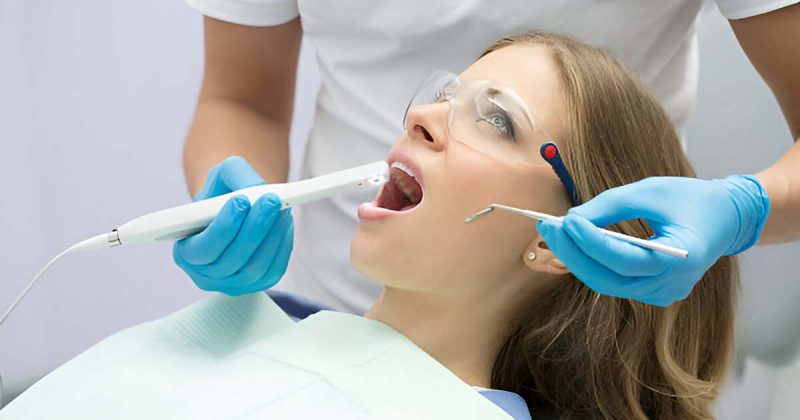
In today’s fast-paced world of dentistry, precision and patient communication are more important than ever. The intraoral camera (IOC) has revolutionized dental care by offering high-resolution imaging that enhances diagnosis, treatment planning, and patient education. This compact, handheld device provides a magnified view of the oral cavity, allowing dentists to detect even the smallest dental issues with exceptional clarity.
Gone are the days when patients had to rely solely on verbal explanations—now, they can see exactly what their dentist sees. With technological advancements, intraoral cameras have become more affordable, portable, and feature-packed, making them an essential tool in every modern dental practice. In this blog, we will explore the history, types, working mechanisms, and benefits of intraoral cameras, along with a curated list of top models to consider when investing in this game-changing device.
What is an intraoral camera?
An intraoral camera (IOC) is a small, handheld, pen-like device used by dental professionals to get a magnified and clearer view of the intraoral structures. It records and captures high-resolution images and videos of the teeth, gingiva, and other oral structures. It easily reaches and navigates hard-to-reach areas and helps in better diagnosis and effective treatment planning.
History:
The first registered trademark of a true intraoral camera that captured intraoral structures dates back to the late 1980s. However, the invention of an intraoral camera was done in 1839. This was the year when the first process of photography was presented to the world by Louis J.M. Daguerre at the Paris Academy of Sciences on January 7th. Later that same year, Alexander S. Wolcott, a manufacturer of dental instruments from New York, designed and patented the first camera from the Daguerre concept. These early photographs were called “daguerreotypes” after their inventor and were a one-of-a-kind image on a silver-coated copper plate.
It was only on July 7th, 1987, that Fuji Optical Systems (Los Gatos, California) received the registered trademark of a dental IOC and released their DentaCam. This was the first analog IOC system. The Fuji DentaCam IOC was sold for $35,000 as a cart system with a monitor and printer.
Later on, Video Dental Concepts also launched its intraoral camera that used a dental endoscopic handpiece. It was the first component-based IOC using a light source, a remote head micro camera, and a dental endoscope. Many intraoral cameras were manufactured with the standard set by the Oral Video Scope IOC, and better features were incorporated, resulting in high-quality intraoral cameras.
The intraoral cameras nowadays are no longer bulky or expensive and do not require much space in a dental clinic. The high-resolution cameras provide a highly magnified and detailed view of all aspects of the oral cavity as required by the dentist to provide the best treatment to their patients.
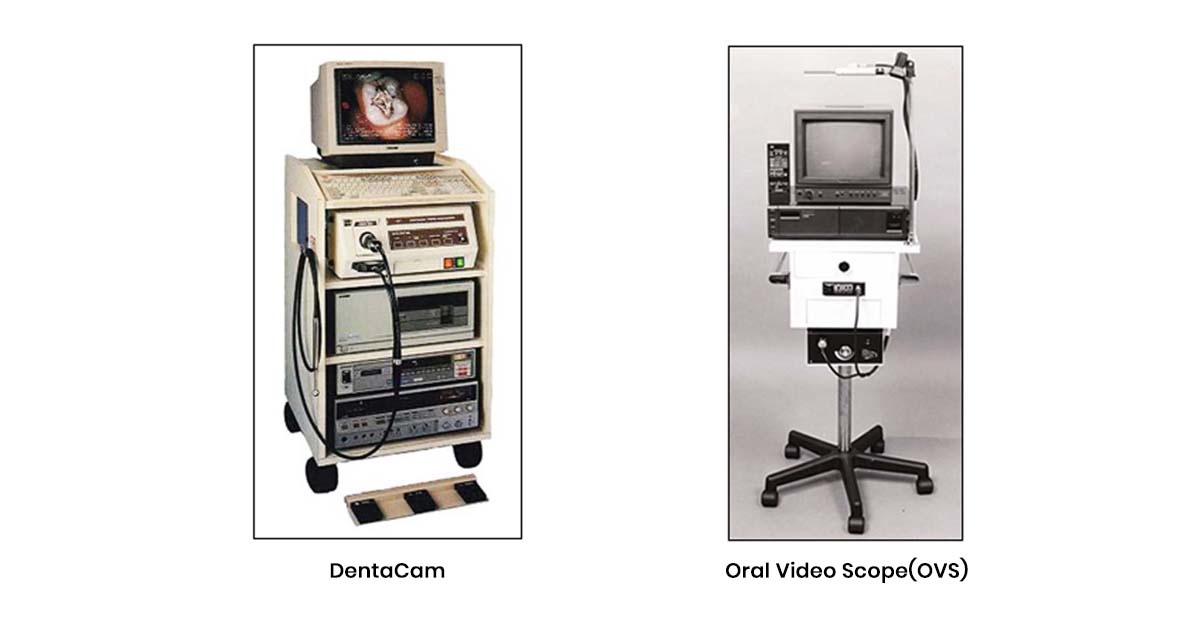
Types of Intraoral Cameras:
Based on connectivity, intraoral cameras can be of the following two types:
Corded/Wired Type:
These intraoral cameras transmit the data through a cable that connects them to the LED screen or a laptop device through a simple USB interface. The wires provide a stable connection but can sometimes hinder movement when assessing structures during the scanning procedure.
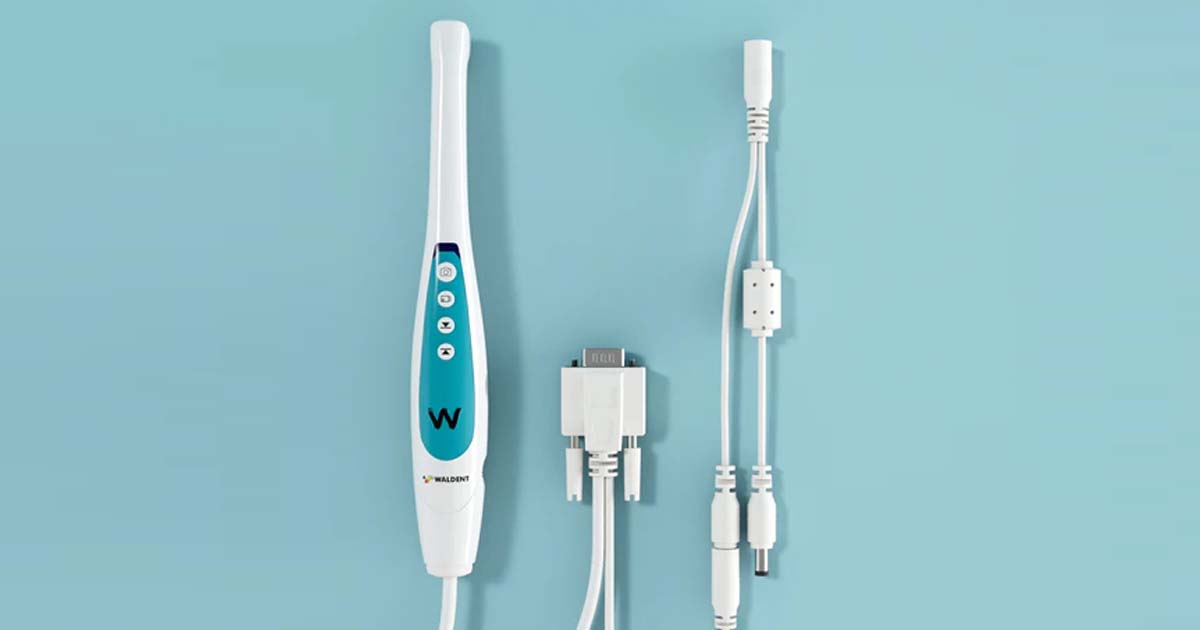
Cordless/Wireless Type:
Cordless IOCs transmit the recorded data through Wi-Fi or Bluetooth functionality to the connected screen. Wireless cameras help dentists move the camera inside the mouth with full liberty, and this also helps them move the screen around to show the oral structures while discussing treatment with a patient.
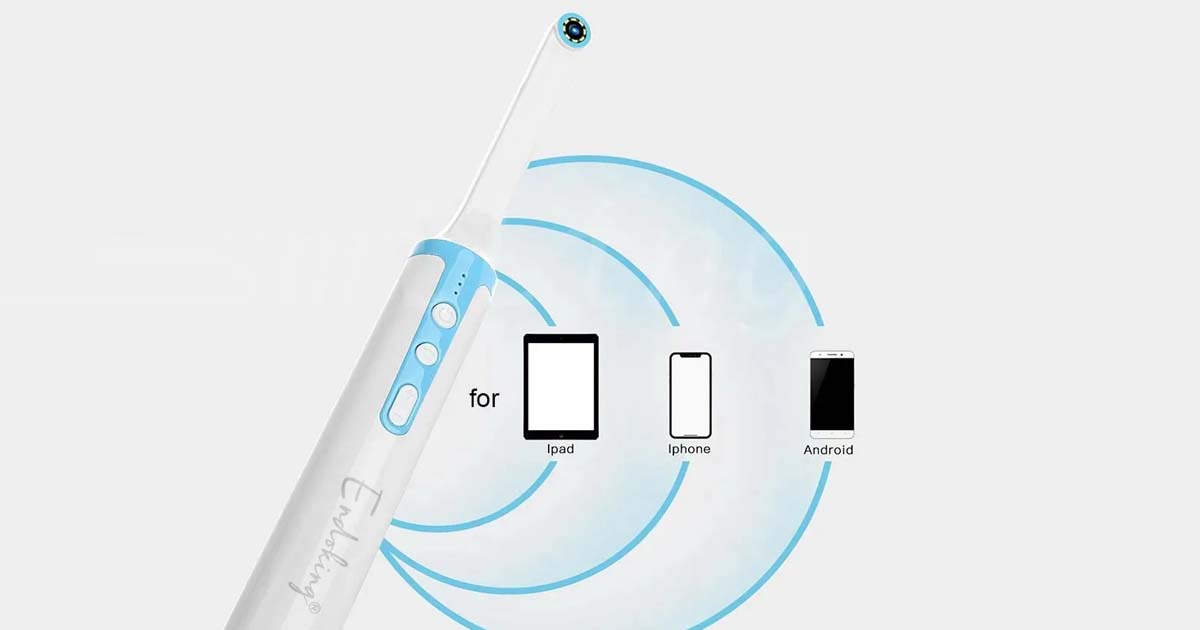
Based on lens type, these can be of the following types:
Fixed Focus:
Intraoral cameras can have a fixed focus lens that does not change the focal length. These intraoral cameras are cheaper than the variable focus ones and are easy to use but produce blurry images when close-up or zoomed-in images are captured.
Variable Focus:
These intraoral cameras have a variable focus lens, i.e., they have multiple focal lengths that the camera can switch between. This feature helps produce clear and detailed images when magnified. Furthermore, they can have manual or automatic subcategories. The manual version has different control buttons to switch from one focal length to another, whereas the automatic one has built-in software that makes such changes on its own with a single-button functionality.
How does Intraoral Cameras work?
The working of the intraoral camera usually involves the following steps:
- Insertion and Navigation: The IOC is inserted and hovered above the structures that are to be captured or recorded.
- Image Capture: The IOC moves above the structures, and the sensor present in the wand receives light and captures the structures, which are then converted into an electronic signal that is processed by IOC imaging software to produce the required image on a display screen for the dentist and the patient to see. All of this happens in just a few milliseconds.
- Magnification: The images captured when zoomed in are magnified versions of the oral structures as seen by the naked eye. The details reveal the presence of cavities, gingival inflammations, tooth fractures, or any other deformity, if present, in the oral cavity of a patient.
- Storage: Images captured can be stored in the built-in memory or on the computer as each patient’s digital record. One can also use cloud-based storage systems to overcome storage limitations. The images thus saved can be used in the future to assess the progress made in the coming appointments.
Uses and benefits of Intraoral Cameras:
Patient Education:
The images captured by intraoral cameras serve as visual aids for providing patients with a detailed explanation. Dentists can effortlessly display and compare teeth to illustrate various dental conditions. These visuals improve patient understanding of their oral health and raise awareness about the importance of maintaining oral hygiene for overall well-being. Additionally, the images enhance the persuasiveness of dental treatments, especially for patients who may have doubts.
Diagnostic Accuracy and Early Detection:
The high-resolution images provided by these cameras allow the dentist to detect even the smallest cavities, tooth fractures, and early signs of periodontal disease that might be overlooked during a usual examination with a mouth mirror. The early detection of such conditions can prevent major damage to the tooth structure that might occur if necessary actions are not taken promptly.
Documentation and Treatment Planning:
The images captured play an invaluable role in treatment planning and documentation for a patient. Pre-operative and post-operative images are crucial in dental procedures such as restorations, veneers, crowns, and bleaching, where they help patients understand the changes in their tooth structure or aesthetics. Furthermore, documenting these images in a patient’s digital record provides a visual history for the dentist to reference during future appointments and monitor the effectiveness of the treatment provided.
Promotes Preventative Care:
Regular use of an intraoral camera promotes oral health for the patients over time. Digital records help track changes in a patient’s tooth structure and aid in timely interventions when needed. Visual evidence of early periodontal disease or minor oral conditions can be addressed immediately, preventing them from progressing into more serious issues.
Enhances Cosmetic, Orthodontic, and Endodontic Treatment:
In cosmetic dentistry, IOCs play a major role in promoting patient satisfaction by showing instant results and helping build trust in the dentist. Procedures like veneers, crowns, bridges, and teeth whitening have an advantage when an intraoral camera is used.
In orthodontics, teeth alignment and the monitoring of aligners and braces’ progress can easily be recorded. The treatment can be further planned according to the patient’s condition, which is checked regularly. It also promotes patient cooperation and enhances their understanding of the treatment.
Whereas in endodontics, intraoral cameras provide detailed images of the extent of caries in a tooth structure so that the chances of secondary caries are reduced to zero. Tooth fractures, which are difficult to detect many times, can easily be detected with the help of an IOC, and a necessary treatment plan can be started. Also, the images captured help in confirming the sealing of the crown clinically, post a root canal treatment in a tooth.
Top 5 Intraoral Cameras and Key Features to Consider Before Buying:
Intellicam 16MP Intraoral Camera
- Image Sensor: 1/4 SONY HAD CCD
- Resolution: 16 MP
- Picture Display: 1 / 4 Pictures
- Focus Range: Fixed: 2cm
- Light Source: 6 White LEDs
- Backup Mode: Auto Backup to U Disk
- Connectivity: USB
- Power Supply: AC100-220V, 50/60Hz
- Waterproof: No
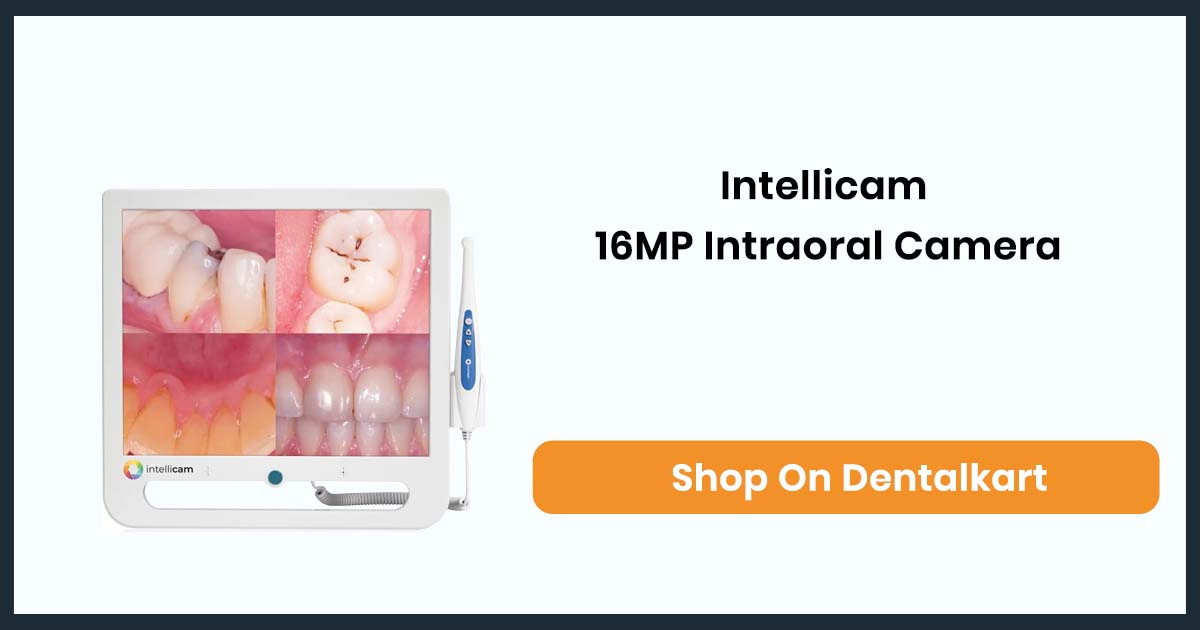
Waldent Intraoral Camera with TouchScreen & RVG Model
- Image Sensor: 12 MP CMOS
- Resolution: 12 MP
- Picture Display: 1 / 4 / 16 Pictures
- Focus Range: 5 – 50mm
- Light Source: 6 Daylight LEDs
- Storage Capacity: SSD: 56GB
- WiFi Transmission: Yes
- Connectivity: USB 3.0, Bluetooth 4.0
- Screen Size: 17”
- Power Supply: 30W
- Waterproof: No
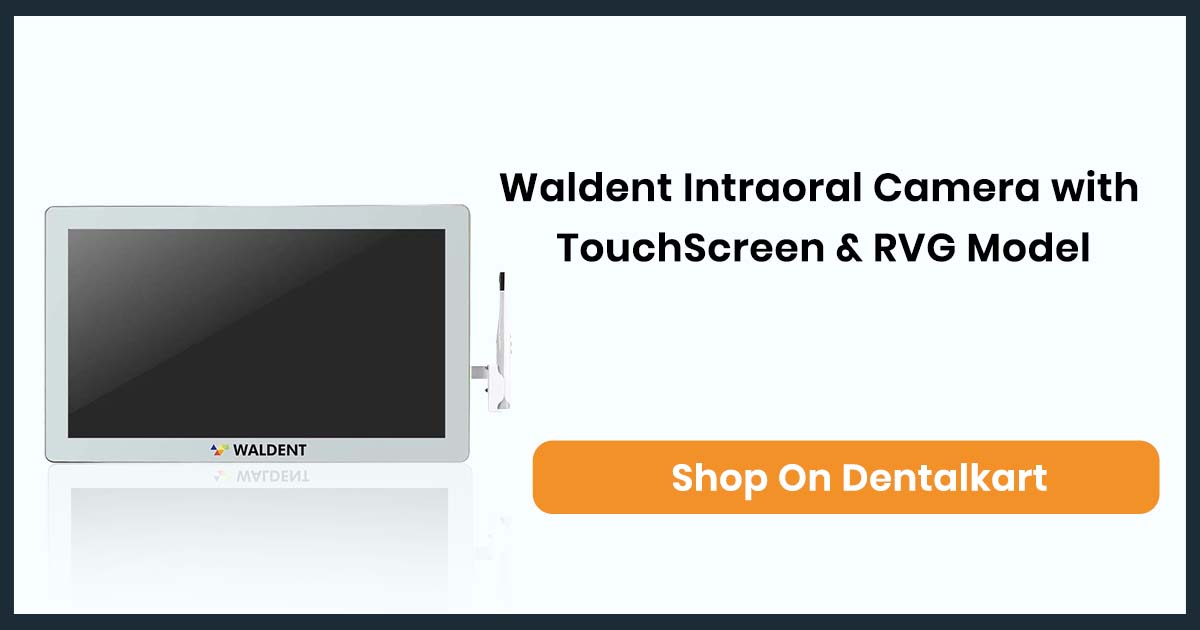
Waldent Intraoral Camera Smart-Cam with PMS
- Image Sensor: 12 MP CMOS 1/4
- Resolution: 12 MP
- Picture Display: 1 / 4 Pictures
- Focus Range: 5 – 50mm
- Light Source: 6 LEDs
- Backup Mode: Auto Backup to USB
- Storage Capacity: Max 32GB
- WiFi Transmission: Yes
- Connectivity: USB, HDMI, VGA, AV, TV/CCTV Port
- Screen Size: 428 x 382.5 x 122mm
- Power Supply: 30W
- Waterproof: No
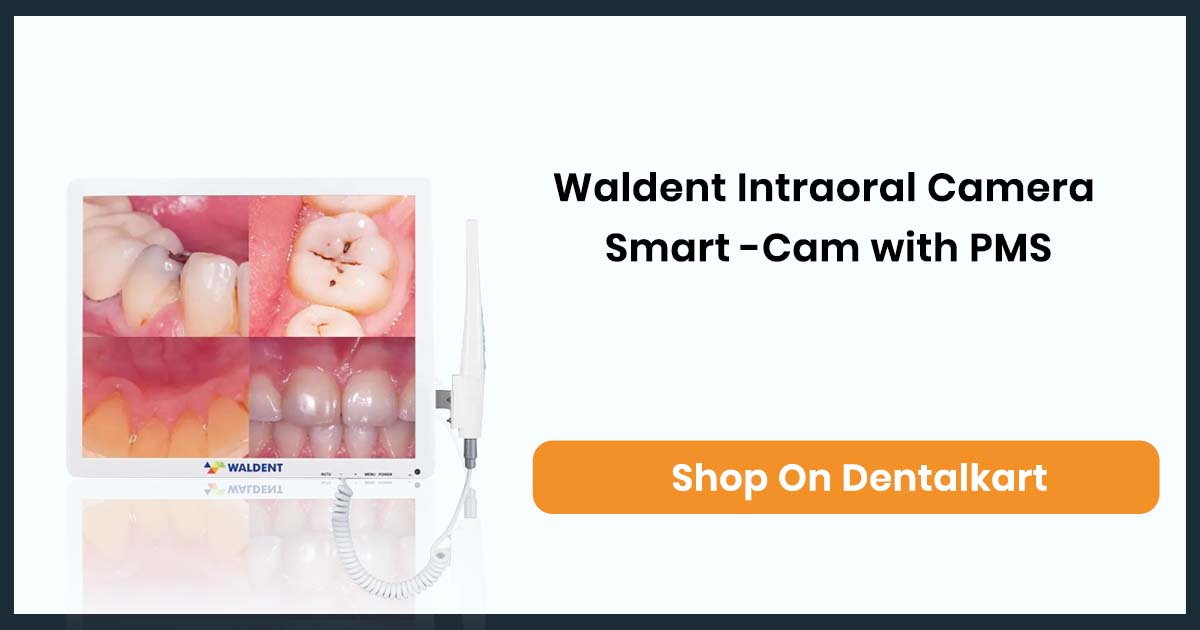
Endoking SuperCam Intra Oral Camera With Wifi (Waterproof)
- Image Sensor: CMOS
- Resolution: 2 MP (1920x1080P)
- Focus Range: 1.5cm
- Light Source: 8 LEDs
- WiFi Transmission: Yes
- Connectivity: Wireless WiFi
- Power Supply: 800mAh Battery (1 hr)
- Waterproof: IP67 (Lenses Only)
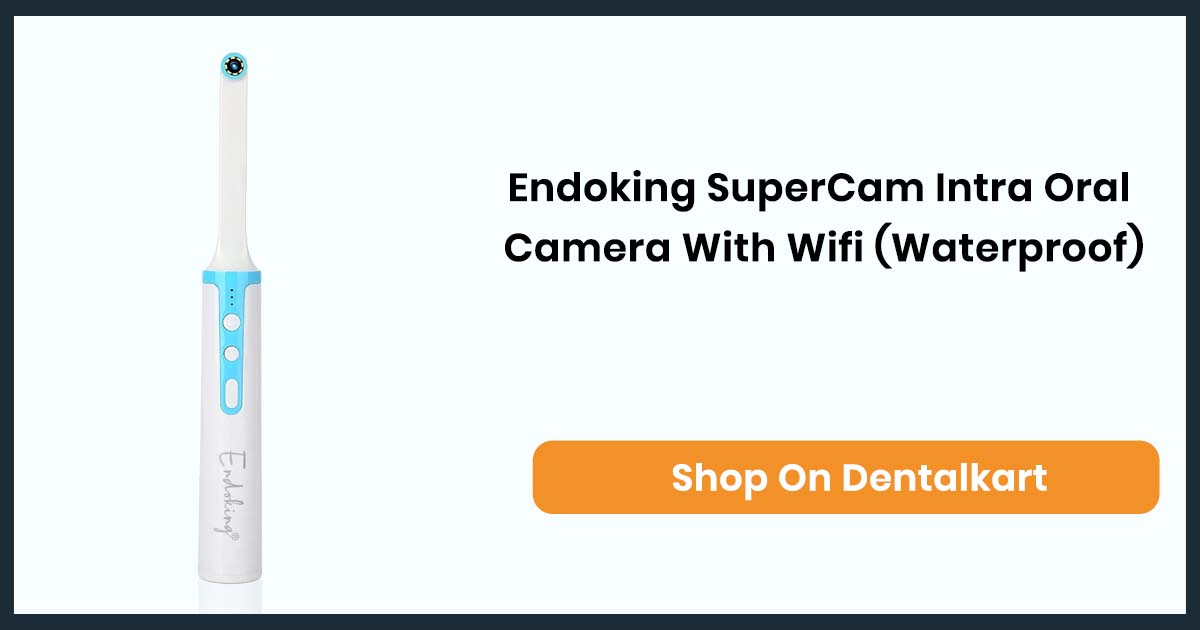
Waldent WiFi Type Intraoral Camera
- Image Sensor: 8 MP CMOS 1/4
- Resolution: 8 MP
- Picture Display: 1 / 4 Screens
- Focus Range: 5 – 50mm (Auto Focus)
- Light Source: 6 Daylight LEDs
- Storage Capacity: Up to 32GB
- WiFi Transmission: Yes
- Connectivity: USB, VGA, R/C Receiver, DV Input
- Waterproof: No
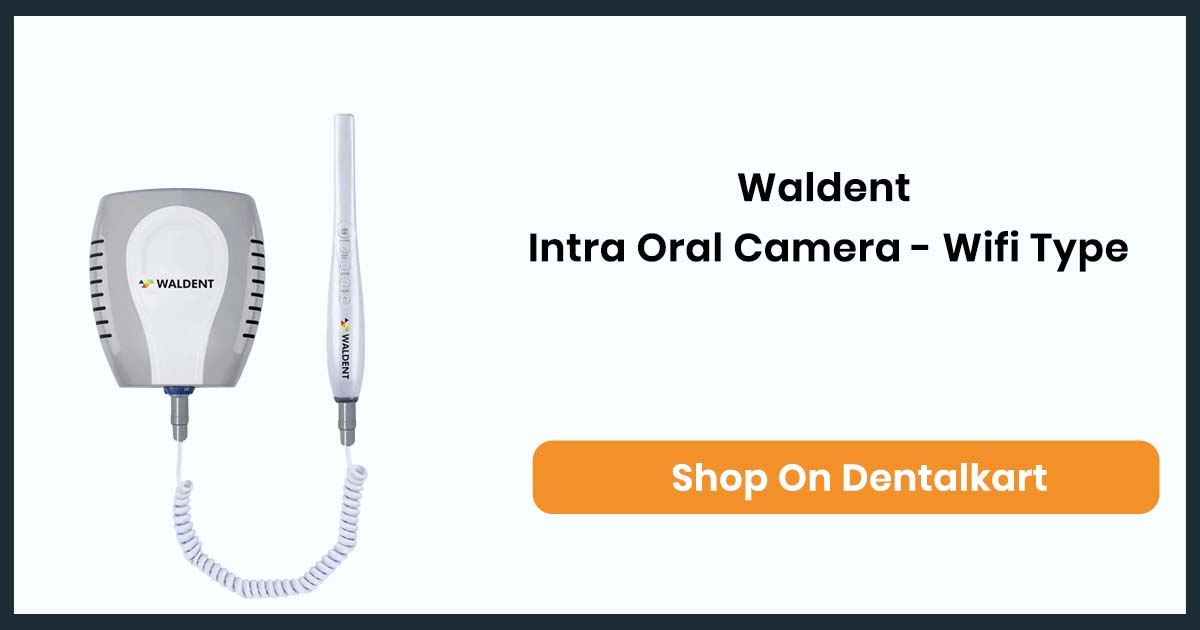
Conclusion
Intraoral cameras are transforming the way dental professionals diagnose, treat, and educate their patients, bridging the gap between diagnosis and patient understanding. Their ability to provide high-quality, magnified images of the oral cavity enhances diagnostic accuracy and allows for more effective treatment planning. With the convenience of wireless options and easy integration into your practice, they are a must-have equipment for any modern dentist.
Investing in an intraoral camera enhances not only the quality of dental care but also patient trust and engagement. If you’re looking to upgrade your practice with the latest IOC technology, explore a wide range of intraoral cameras on DentalKart and find the perfect fit for your clinic.

No Comment